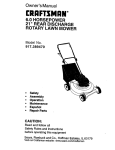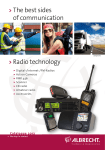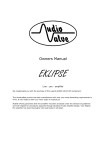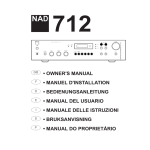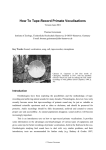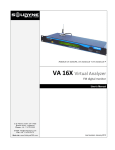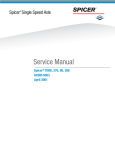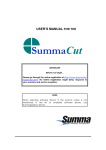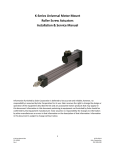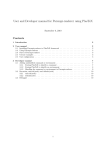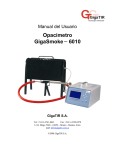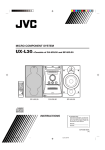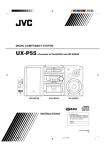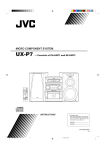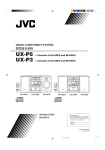Download Reel to Reel Recorders
Transcript
Reel to Reel Recorders In the old days there was no DAT, no DAW and no CD. No wav, no aiff, no mp3. All you had was tape. Tape was not perfect, it wasn’t 100% accurate and truthful and so the digital age was a relief for a lot of audio enthousiasts and studio personel. But to some the side affects of analog recording are also pleasing; the compression of the highs, the thicker bass and the saturation give the illusion of a fuller, warmer and more musical sound. Some try to re-achieve that effect and use it to benefit the overall sound, either digitally or... naturally. Whether you considder it to be a matter of nostalgia or taste, recording to tape does influence the final product, like a compressor, a reverb or an equalizer affect the overall sound. This little article isn’t about analog vs. digital, it’s only about what to bear in mind on your search for a reel recorder. I am no expert at all, I’ve only been searching for- and recording to reel recorders for some years. I often get questions about what to look for in a reel recorder so I hope my experiences can be helpful to some. This article is mainly meant to point out what you should consider on your search for a good reel recorder, but since the term ‘quality’ can be explained differently it might be useful to explain what tape is and how taperecorders work. Tape Recording tape is a polyester band with a coating of randomly aimed magnetic particles, like a formulation of chrome dioxide or ferro oxide. During recording, a magnetic field aligns the particles into a magnetic pattern that represents the recorded signal. Tape formulation is an important factor as it is of influence to the recording and recollection of the signal, especially where it comes to high frequencies. It also affects the S/N level, print through and bias, and even the chance of physically wearing the heads. The polyester band used to hold the coating also affects the quality of a recording since it’s elasticity and strength affect wow and flutter, and it’s thickness affects the printthrough. Heads On any recorder, heads are the number one part sensitive to wear. The heads are electromagnets that convert an audio signal into a magnetic field and vice versa. Most pro and semi-pro recorders use three heads. The recorder will have one erase head, one record head and one playback head. Older consumer recorders have often a combined record / playback head. For the studio 3 head recorders are preferable because they have a monitor function: by pressing the playback head onto the tape, you can immediately hear what you just recorded a few seconds ago. (*Because the playback head has a few milliseconds of delay to the actual recording, you can also us a three head recorder as a tape delay). Using bias, the erase head makes a magnetic field that orientates the particles on the tape randomly, erasing the ‘magnetic history’ they were holding. The record head converts the incoming signal into a magnetic field that changes as the signal does and aligns the particles on the tape. As the tape passes the playback head it picks up the magnetic pattern created by the record head and changes it back into an electronic signal. That signal gets amplified and equalized and send to the recorders outputs. to be realigned as well. Better maintaim them well to get most hours out of them. Head wear can indicate how well the recorder operates: if one side of the head has more wear then the other, there could be something wrong in the tape transport or in the way the heads are aligned. Some recorders have butterfly heads, which are less sensitive to wear, and some companies (like Revox) made softer heads than others. Inform yourself of the type of heads on a machine; hard heads and butterfly heads will give you more hours of recording. All heads have a vertical line, a gap, on the heads surface. On the record head this gap is actually what puts the signal to tape, and on the playback head it’s what reads the signal from the tape. Because this part of the heads surface is in contact with the tape, it might get worn over time. A bit of wear isn’t a problem, but too much wear will be audible and you’ll need to replace the heads with new ones. This can be expensive, so when you buy a recorder see that you check the heads for wear (and oxidization). When you get the recorder, maintain the heads well; Spare heads can be found new, either with the original manufacturer or third party sellers. Relacing the heads, requires them The supply and take up reel give tension to the tape. Aged motors might not give enough backtension or pull and throw the tape into a loop, or make the machine difficult to start up. The capstan is a metal spindle that rotates against a rubber pinch roller. The tape is pressed between these two, and gets pulled across the heads. Besides these parts there will be an extra tape wheel(s) and tension arms to guarantee a smooth tape transport. These are equally important to reduce something called wow and flutter: audible variations in tape movement. When you buy a recorder, try to be sure that all transport parts are functioning and running straight. If for instance the capstan is slightly out of balance or even dirty it can affect the quality of the recording. But also differences in the way the pinch roller(s) have worn or the axis of the supplyand take-up reel tables will influence the way the tape passes the heads. Tape Transport: Feed Reel / Supply Reel, Take-Up Reel, Capstan, Pinch Roller, Tension Arms Tape should be transported across the heads on an average speed with an average tension, as it affects the quality of the recording. To transport the tape most (especially semi pro- and pro-) recorders have three motors: one for the feed reel or supply reel (which supplies back tension), one for the take up reel (which ‘pulls’ the tape), and one for the capstan. With most recorder designs, the tension arms activate the machine. When a tape is pulled through the tape path and mounted to the takeup reel, the tension arm moves up and activates the reel motors and capstan motor. If the tension arm has a problem (often caused by a loose spring), the machine might not get activated properly. For instance, if you hit play, the tension arm shoots down and deactivates all the motors. However, this can also happen because the reels motos don’t give enough backtension or pull. The capstan (and on 2 motor recorders the take up reel) are often driven by a rubber belt. These rubber belts are subject to age so often this belt needs to be replaced. Pinch rollers are made out of rubber and rubber can dry out, especially when it’s cleaned with alcohol, so it’s important you check the state of these pinch rollers. Pinch rollers can be lapped when they are unequally worn but nobody can do wonders. Pinchrollers are also subject to age and will look cracked and / or glassy when they are too old. Needless to say, most rotating parts have bearings that are subject to wear and need to be lubricated or replaced from time to time. Bad bearings will make a nasty squeeking noise and will make the machine literally run less smooth. Tape saturation You probably heard a lot about it, but what and how does it affect the sound? As mentioned earlier, recording tape has a coating of randomly aimed magnetic particles that get aligned into a magnetic pattern representing the recorded signal. If the signal level you record to the tape is strong enough to magnetize all the particles, an even higher signal can’t increase the magnetic signal on the tape which results in a fuzzy sound of distortion. It’s that distortion that’s called ‘tape saturation’. So the saturation point is determined by the recording level, but it’s also influenced by the formulation of the tape, the width of the tape A tape with a width of a 1/4 inch saturates sooner than a 1 inch tape. An 8 track 1/4 inch recorder will saturate sooner than a 2 track 1/4 inch recorder. A recorder winding the tape at 7,5 inch per second will saturate sooner than a recording winding the tape at 15 inch per second. Signal-to-Noise (S/N or SNR) Signal-to-noise level (or ratio) compares the level of a recorded signal to the level of the recorders own noise level. For reel recorders many different aspects influence the S/N level, such as record level, tape width, tape speed, the formulation of the tape and the head gap. Hiss / Tape Noise As said, a loud input level can lead to saturation of the tape. However, a low input level can lead to a noisy signal, called tape hiss. On the unmagnetized tape the particles are aligned randomly, but there is still an audible high pitched type of noise: tape hiss (or tape noise). Whilst a high level will saturate the particles, a low level will leave particles nonaligned. If the recorded signal is too low the tape noise will stay noticeable. Noise Reduction A lot of recording studios where confronted with a catch 22: a high input level causes saturation, a low input level causes hiss. Unless they were recording some rock band they often didn’t want either to take place. Enter the noise reduction units. The most well known noise reduction techniques come from DBX and Dolby. Both systems work differently: basically Dolby pre-emphasizes a high frequency on recording and de-emphasizes it on playback, DBX compresses the dynamic signal on recording and expands it during playback. Both would eliminate tape hiss and (and this might be of concern to some) tape saturation. DBX probably eliminates tape saturation better than Dolby but saturation on a Dolby recording might be different and less pleasing than on a recording without Dolby. Especially on multitrack recorders noise reduction can be useful because every track will have noise, so more tracks will present more noise. On 2 track mastering recorders noise reduction can be equally useful, but you have to decide what type of sound you’re actually looking for. Record and Play Back Equalization Recording to tape affects the high and low frequencies of a recorded signal. To improve the S/N level the recorder itself equalizes the incoming and outgoing signal meeting standard specifications. During recording, it slightly boosts the low and high frequencies, at playback it cuts these frequencies again. Depending on the make of the recorder and the tape formulation compression remains a side affect, and there are different EQ curves (NAB, IEC and AES) with their own specifications. Print Through A reel of tape is a spool of many layers. Since these layers are magnetized, they can affect each other, leaving a weak copy of one layer on another. This copied magnetic information can be audible as a dull sounding pre- or post echo of a recorded signal, which is called ‘print through’. To avoid print through tape manufacturers tried different tape formulations that required different levels of bias (ie pre-magnetization). Also the thickness of the backing material (thus the polyester band that holds the magnetic particles) is of influence to print through, as well as the duration and conditions of storage. Tape Speed Tape speed is one of the factors that will influence the S/N level. Tape speed is indicated in inch per second (ips). Often, semi-pro and pro recorders can only record on 7,5 and 15 ips, sometimes even on 30 ips. In order to get as many minutes as possible on one single tape, consumer machines will most of the time record at 7.5 ips, 3 3/4 ips and / or 1 7/8 ips. Even most consumer recorders suitable for 10,5” reels would not record on 15 ips. The decrease of speed will give you more minutes to record, but it will also most certainly effect the quality of the recording. The higher the speed the more headroom you have and the less noise and saturation you get. Recording on at least 7,5 ips is recommended, in the studio it’s nicer if you can choose between 7,5 or 15 ips. Quarter Track, Half Track, 4 Track, Multitrack 2 track stereo recorders are often referred to as half (1/2) track recorders because they use half of the tape for a channel. But what about 4 track and 1/4 (quarter) track recorders? They both use a quarter of the tape, so what’s the difference? Except for low recording speeds consumers where helped to save even more tape and thus money by using a system that allowed to use tape in 2 directions, a bit like a cassette deck (but not quite). The quarter track recorder has 4 tracks to record 2 stereo signals, by flipping the tape. 2 channels (L+R) are recorded on track 1 and 2. When the feed reel is empty and all the tape is now on the take up reel, you remove the reel from the take up reel and put it back on the feed reel. Now you can continue to record 2 channels (L+R), but this time track 3 and 4 are used. Quarter track recorders often utilized this way of recording into fun functions they loved back when recording stereo was a living room novelty: family fun proto-karaoke functions like Sound-on-Sound recording, Sound-With-Sound recording, but also echo can often be found on early 70’s consumer quarter tracks. For mixing down a final stereo mix a quarter track recorder might turn out to be disappointing because effectively you get less tape width for a stereo recording than you would get on a regular 2 track (or should I say 1/2 track?). I noticed that at least here in the Netherlands consumer quarter track recorders are often advertised as being 4 track recorders. This is wrong, because a 4 track recorder is a recorder that records 4 tracks in one direction at the same time: a multitrack recorder. Multitrack recorders come in many formats, ranging from 4 to 48 tracks. They are ideal for recording multiple takes of one song, for overdubbing or for being able to practice or work on a final mix when the band has already gone home. The more channels they have, have, the more technically complicated they get. Setting them up prior to recording takes time, and you’ll spend even more time if you plan to do some overdubbing. Calibrating, using and maintaining a multitrack recorder is harder and more expensive. If you buy one, I advice you buy one with a maintenance history (ask for receipts) or get one from a company that specialises in buying, restoring and selling reel recorders. It will be more expensive, but in the end you’ll spend the same amount of money, minus the headaches. Although a multitrack is like having several stereo 2 tracks I figure you best use it for what it’s supposed to. Because of noise issues, using a 4 track as if it were a 2 x 2 track stereo recorder (by recording 2 x L and 2 x R) isn’t necessarily a good idea. If you want to mix down a stereo recording to tape, I suggest you use a 1/2 track stereo recorder. Tape Width There’s 4 standard tape widths: 1/4 inch, 1/2 inch, 1 inch and 2 inch. The width of the tape is important for the headroom, dynamic range, the S/N level, even more so when you´re looking at a multitrack recorder. A 24 channel 2” recorder will effectively have a smaller track width per track which compared to a 1 inch 2 track recorder, which will result in the same artifacts you’d get on a 2 track 1/4“ recorder. For 2 track recording, 1/4 inch, 1/2 inch and 1 inch recorders are quite common. Quarter inch tape is cheap and tape compression and saturation is very easy to achieve. Of course there’s downsides as well, like saturation (yep, some consider this a con), crosstalk, noise and a bad dynamic range. If you get wider tape these artifacts get less obvious and you’ll get a more high fidelity recording. But tape will be far more expensive, not to mention buying and maintaining the pro recorders you’ll need these tapes for in the first place. If you look at it 1/4” tape might seem a bad choice for mastering, but the artifacts can also be pleasing and charming to hear, it gives a unique sound that is hard(er) to get with wider tapes. And a well maintained and aligned 1/4” recorder will sound better than a neglected 1/2” recorder. What type of recorder you should get really depends on the type of music you record, your personal ideas about ‘quality’ and, last but not least: your financial position. 10.5” Reels or 7” Reels For the quality of the recording at 7.5 ips it shouldn’t matter what reel size you get, only differences is the number of minutes you can record. But since most 7” recorders can not record at 15ips speed (the only exceptions I know of are the Tascam 22-2 and 22-4 you might be best of getting a 10.5” recorder. However, even a lot of 10.5” consumer recorders won’t run on 15ips, and as mentioned earlier tape speed is of influeuence to the sound quality. Of course you can mount 7” reels on a 10.5” machine, altho on pro recorders this might be a problem because of the needed back tension and pull. Keep in mind that depending on the tape speed and the inches of tape on the reel the available minutes of tape will vary: a 10.5” reel will give you 30 minutes on 15 ips, a 7” reel 15 minutes. So it can be a economic decision to go for a 10.5” recorder and only use it at 7.5 ips, this will give you 60 minutes of recording. Smaller, 5” reels can be found on older (portable-) reel recorders and field recorders such as the (beautiful) Nagra IV. Hub Adapters / NAB Hubs The National Association of Broadcasters is an American association that introduced standards for the broadcasting industry that are often adopted world wide. Most of them concern broadcast quality (like the NAB EQ curve to improve S/N), but at least one standard was a safety measure: the NAB hub. When rewinding tape, the empty reel rotates at a tremendous speed. Sometimes reels couldn’t withstand these speeds and would break free and launch themselves in the studio, damaging or hurting anything or anybody in it’s flight path. So the NAB introduced a standard clamp design that could hold the reel tightly to the machine. This might seem an unimportant little trivia, but when you buy a second hand recorder that’s suited for 10,5” reels (7” recorders never use hub adapters), it would be nice if it comes with NAB hub adapters because a lot of 10,5” reels you buy are only suited for these hubs. If no hubs are supplied they can still be bought new, some are even extra fancy and made out of aluminium in a fun colour and with a bigger hub that makes it easier to tightly mount the hub. 10.5” tapes are also available with ‘trident’ fitting. For these reels you do not need a hub adapter. AEG Hubs / AEG Spooling plates, Pancakes Another type of hubs are AEG hubs. They are meant for mounting tape on AEG spooling plates. AEG spooling plates or ‘pancakes’ are flat reel plates you won’t see often except on pro recorders (or older AEG Magnetophone recorders, hence the name). If the recorder can be used lying down instead of standing up, you don’t necessarily need a regular reel to hold the tape anymore. It’s easier to mount the tape to the recorder and winding and unwinding the tape will go tighter on a recorder that’s lying down, which can improve the wow and flutter. Pancakes also make buying tape more economic. Buying Tapes: New Tape There’s many types of tapes for as many purposes. Most consumer and semi pro machines will be set up for different tapes with different formulations and different bias types. Most (semi-) pro machines are aligned to be used with one type of tape only. Depending on the bias, what tape should you get? Well, as for brands the market pretty much narrowed your options down to 2 brands: ATR (USA) and RMGi (Netherlands). ATR doesn’t produce 1/4 inch tapes, so if you buy a 1/4” recorder you have only RMG tapes to choose from. The RMG product range is pretty wide so no worries there. RMG uses the old Basf/ Emtec formulations. The SM tapes are your best choice when you record in the studio, the SM number depends on the bias of your machine. My own recorder can’t take SM900 or SM468, which are High Bias tapes, so I stick to SM911. The LPR and PER tapes are probably better suited for archiving and / or for use with conventional long play consumer recorders, and perhaps (I have no experience with them) for use with tape echo’s. Because of the rougher particles used, they might wear heads sooner. Buying Tapes: Second-hand tapes, NOS tapes and Sticky Shed, Baking When you search for other brands of tape, like the almost legendary but unfortunately out of production Ampex / Quantegy 456 tapes, you’ll often find them listed on private seller sites like E-Bay. Most of the times listed as used, but sometimes listed as New Old Stock (NOS): sealed and never used reels of tape. Buying these tapes is tempting, especially if your machine is calibrated for these out of stock tapes. However, you have to be very cautious because of (sticky-) shed. As explained earlier, recording tape is made of a polyester band with oxide particles. To hold the oxide particles on the tape a special binder formulation (glue) is used. Sticky shed comes from the degradation of the binder. If the binder degraded, particles of oxide will shed all over tape path and beyond. If the particles are still sticky, the tape is even unplayable and cleaning will be even harder. Storage and age are an important factor in the degradation of the binder and therefore I figure it can only be obvious that (unless you’re a hi-fi enthousiast looking for recordings) you’re better of avoiding second hand tape. But why avoid NOS tape? The type of binder and the process used by the manufacturer can also be of influence on the degradation of the tape. In the 1980s for instance, manufacturers used a certain popular type of binder that later turned out to be causing sticky shed problems. There are some people who keep track of sticky stock tapes but I personally think it’s just best to also stay clear from any NOS tape, because you can’t always be sure on what exact batch your bidding. There are definitely exceptions and a good deal can be made, but if you don’t know the answer to the question ‘why wasn’t it sold when it was simply New Stock?” you should better leave it and go for new ATR or RMG tapes. In my humble opinion, if you find a second hand recorder that comes with a few reels of old, either used or unused tape it should not affect the price in the sellers benefit. Tape can be baked (yep, in an oven) to reactivate the binder. It’s a specific process that can be used to salvage tape and / or the recordings on them. Reel to reel, cassette or VHS? Reel to reel recorders are without a doubt a charming and effective devices for a recording studio. But they can be hard to find in a good maintained state in a time where it also gets harder and harder to find spare parts. Tapes are rather expensive as well, especially if you just want to fiddle around a bit. For this reason some people decide to find analog recording alternatives, like cassette tape or even videotape. Cassette tape can be an alternative for ‘that analog sound’ but it is sometimes limited and can easily be less favourable compared to a reel recorder for making master recordings. The tape width is only 1/8” which is more limited for making decent studio recordings and on most consumer recorders the tape speed is not adjustable. This makes cassette more sensitive for side effects you might not like. Some of the limitations have been made up for with noise reduction and tape formulations containing finer particles. But because of the low recording speeds wow and flutter always remained an issue on most recorders. Even a consumer quarter track at 7,5 ips will be favourable for obtaining artifacts such as saturation and compression, which in essence make ‘that analog sound’. Finding a 2nd hand cassette recorder in good condition is as hard as finding a 2nd hand reel recorder. VHS isn’t an ideal replacement for recording analog at all because it uses a completely different technique called AFM to write audio information to tape. Because of this technique ‘tape saturation’ or ‘tape compression’ do not exist on VCR’s. Most consumer hi-fi recorders set the recording gain automatically, so if you get any distortion it will probably be because you’re overdriving the inputs, not because you’re saturating the tape. To back up and store music hi-fi VCR’s can be a solution but in these days of cheap hard disks and soundcards I doubt if even that purpose is a good motivation Maintenance First of all: keep the recorder in use. A recorder that stands still for longer periods can show trouble just as well. If you don’t use if often, clean it after you stop using it, and clean it when you start operating it again. When you buy a machine it’s perhaps wise to see first whether the important parts of the tape transport and tape path are easily accessible for these typical maintenance chores. A service manual could be very helpful, especially if some maintenance chores require the machine to be taken apart. Most regular maintenance chores can be done without a service manual Cleaning the Tape Path The tape path is anything the tape passes after the tape left the reel: tension arms, pinch rollers heads, capstan and all other (metal-) parts such as the tape guides. It is important that this entire path is kept clean and maintained so that everything keeps running smoothly. When the sound of recording and playback gets distorted or fuzzy or dull it’s definitely time to clean the tape path, but it’s better to just do it before every (important-) recording. Heads and Capstan The heads and capstan can be cleaned with 96% (isopropyl-) alcohol. It needs to be as pure as possible as it doesn’t contain much water. It doesn’t leave any residue and evaporates quickly. To apply it you’ll need a cotton swab or q-tip or whatever you call them. You can also get Chemi-swabs, special swaps that are pre-soaked in isopropyl alcohol. All should be obtainable at your chemist / pharmacist. Don’t use force on stubborn parts, you might move the heads a tiny bit. Just use more alcohol. Pinch Rollers For pinch rollers you must not use alcohol as alcohol dries out the rubber. Remove the pinch rollers and clean them with water with a tiny amount of a mild detergent and a soft toothbrush. Whatever you do, make sure non of the alcohol or detergent enters the machine or touches other parts like the pinch roller’s bearings and that you dry all parts before mounting them back on the machine. Mechanical parts need some service as well. It’s nice to have a service manual to do this. Mechanical bearings should be lubricated from time to time with a small amount (a drop will go far) of sewing machine oil. While your inside the machine, look for signs of wear: scattered rubber, glassy or cracked looking belts are an indication of wear, these rubber parts must be replaced very soon. Demagnetizing the Heads Magnetized heads can be the cause of dull sounding recordings, drop outs and other unwanted side effects. Once in a while, depending on how often you use the recorder, you should also demagnetize the heads with a special tape head demagnetizer (or ‘head degausser’) like the R.B. Annis Han-d-Mag, which is still in production. The tip of the demagnetizer should have a rubber end so you won’t accidently scratch the surface of the heads. Here’s a step by step demagnetizing guide: 1) Turn the power of the recorder off 2) Keep the demagnetizer well away from tape or tape machines (at least 3 feet / 1 meter) 3) Move the demagnetizer towards the recorder until the tip contacts the parts of of the recorder. Demagnetize the heads, guides, and the capstan. 4) Move across all the metal part’s surfaces, from one part to the next, all very slowly and smoothly. If you slip and move fast, go back and redo that part. 5) When you’re done doing all metal parts, very slowly and smoothly move the demagnetizer away until you are again at least 1 meter away. 6) Turn the demagnetizer off. Never turn the demagnetizer off before it’s 1 meter away from the machine, as you might end up magnetizing the parts instead of demagnetizing them. You don’t need to move the demagnetizer very slowly towards the recorder, only when you move it away from the machine. Head Alignment and Calibration If you plan to replace worn heads with new ones be aware that you need to align and calibrate the recorder. Depending on the hours you use it, alignment and calibration is also something you might have to do every few years. Heads need to be correctly aligned and calibrated to get the best result out of a recording; the bias needs to be correct for the tape you plan to use and the position, the heads should be correctly aligned and the playback- and record eq (NAB, AES or IEC) should correspond to the tape you want to use. Aligning and calibrating the recorder can be done by the user, but it’s not something you should do without owning a service manual and a reference tape. You’ll need a reference tape with pre-recorded test signals to help you align and calibrate the recorder. It’s a specific task that requires specific tools and expertise so I think you’re better have an experienced technician do it for you. Repairs Some manufacturers still maintain and repair recorders. If you happen to buy a machine that’s still supported by the manufacturer, keep in mind that shipping the entire recorder can become expensive. Therefore it is nice to have a machine on which you can easily take the vital parts apart so you can send the part to the manufacturer (or repairman) for review and repair. A service manual often holds many treasures of information. They might make it possible for you to do minor repairs yourself, or at least make it possible to correctly take the machine apart. Parts Parts are sometimes still sold by manufacturers or third parties, or can be found on private seller sites like e-bay. To avoid surprises, make sure you can actually get service and / or spare parts, and be aware of their price. Buyer Beware Since there’s no manufacturers that build reel recorders anymore (except for ATR, they still produce the ATR100) you’ll have to buy one used. Best is to buy from a company that’s specialised in restoring recorders. It will seem a lot more expensive but in the end it will be more economic and it will safe you from worries. With private sellers you just never know what you’re gonna get, even if you inspect it well. If you buy one from a private seller you must inform yourself of the overall state of the recorder. Prepare Yourself - Imagine the disappointment when you find out that the half track recorder you’ve been looking at for so long is actually a quarter track… Always check the type and make and be sure it is really what you think it is. Search for info on the recorder: what versions where there, and how do they compare? Some recorders have different makes (MKI, MKII, MKIII, etc) or product numbers, with different specifications. Take for instance the popular Revox A77: it came in different makes, in different speeds and in quarter track and half track versions. It can all be very confusing, especially if a seller doesn’t list any specs or details in the advertisement. - See that you also do a bit of web research on the exact make of the machine you’re looking at. Some (if not all) recorders have their own specific and typical problems that you must inform yourself of. - Is the machine easily accessible for repairs and maintenance? - Everything can be bought, but at what price? If the recorder your looking at comes without spare parts (which is most likely) check that these parts are easy to get and make sure you know their prices. Take a Good Look and Ask Questions - Check the heads and buttons for signs of wear and oxidization. - Check the tape transport: capstan, pinch rollers, tension arms, bearings, brakes, motors, counters, reel tables, tape guides. Does the machine start-, run- and brake nicely without throwing the tape into a loop? Do the rubber parts look good, i.e. not shiny or cracked? Do the bearrings not make a squeeking noise? After winding at full speed, does the reel ‘roll out’ nicely? - Check the machines history. If the seller says it’s always been serviced, ask for receipts. - Ask the seller for what specific tape(s) the machine is calibrated. Often private sellers have no clue, but it doesn’t hurt to ask. - A machine that’s sold with a service manual, user manual, reel clamps, tools for maintenance, (un)used spare parts and fun extras like a remote is favourable to one that comes without any. - Old tape is often worthless and should not influence the price in any way. Get the Stuff You (Might) Need - Isopropyl alcohol can be obtained from the pharmacist. They’ll probably sell good Q-tips as well; the real cotton ones that don’t leave fibres. Special pre soaked cotton swaps can also be bought, but are more expensive. - New tapes are made by RMGi and ATR (no 1/4” with ATR tho). You can buy them online. - Empty take up reelshub adapters can often be bought from the same places you you order tape. - A demagnetizer can be bought new. 2nd hand is an option, new ones can be bought from R.B. Annis and Bernsteinn, a.o. - Reference tape can be bought new. I never bought one myself, but this German seller was pointed out to me by a friend (German language site): www.bluthard.de/index.php?testbaender-1 To Conlude Quality is subjective term. Do you want to record to tape because it sounds more true, or do you want it because you can use it as an effect in the studio? Either way, a reel recorder is a demanding piece of machinery; it needs constant attention. Some reel recorders never received this attention and their price will be accordingly; or at least it should be. As said before, I am no expert, just somebody who uses a reel recorder regularly. I probably covered only half of what there is to be known, tape recorders are complex when you look at them in detail. But the general idea is quite simple, and you don’t need to know everything there is to it. If you do want to know more, lots of information can be found on the internet and my ‘guide’ should at least be able to point you in the right direction.













